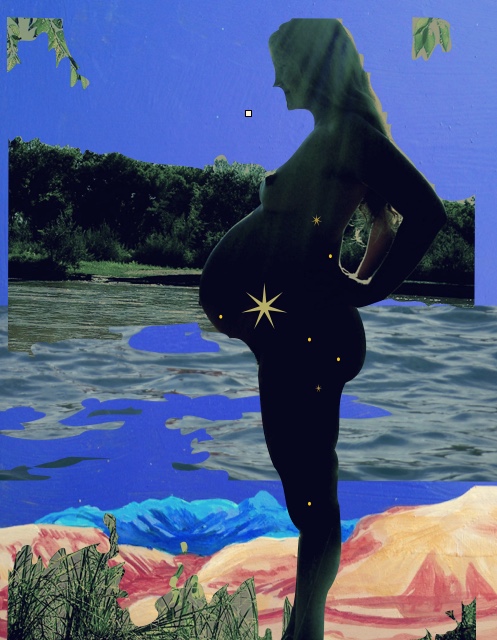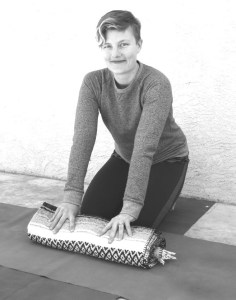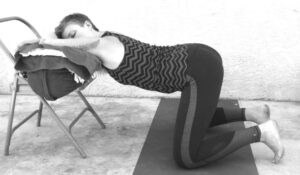
Bhakti Yoga, Karma Yoga, Decolonizing Yoga

Bhakti Yoga, Karma Yoga, Decolonizing Yoga
The following is a piece is inspired by the work I’m exploring in both the Albuquerque Waking up to Whiteness course and Denver Iyengar Yoga Teacher Training.
In contemplating my embodied experience of the definitions BKS Iyengar lays out in the introduction to Light on Yoga, I am inequal measures reflecting about the marga, or path, of Bhakti Yoga, and of Karma Yoga. I am interested not only in each separately, but in the places where the two intersect: the field of spiritual justice.
I understand Bhakti to be the love and devotion to a divine and seamless wholeness, as described in the Isha Upanishad, which the individual soul is an aspect of, and Karma yoga to how we relate to others, interact, and how we can truly serve in the complex context of the external manifestations of our collective existence. (Of course Bhakti and Karma margas could both be analyzed in internal and external ways, but for the purposes of this paper I will explore them to correspond in this way, since that is how I have experienced them.) I have felt at times a dissonance between the inner and outer work, between my yoga practice and my drive to serve peace and justice in the external. Intuitively, I sense these two types of work – inner liberation, and collective liberation – to be inseparable. Looking at the ways they overlap, merge, and support each other is of great interest to me. In the introduction to Radical Dharma, angel Kyoto williams writes eloquently on this topic:
“Each community possesses, as Gandhi offered, a piece of the truth, of dharma. When we seek the embodiment of these truths, giving ourselves permission to be more honest, more healed, more whole, more complete – when we become radical- neither the path of solo inward-looking liberation nor the pursuit of an externalized social liberation prevails, rather a third space, as-yet-unknown, emerges. It is a radical dharma. And it is ours. …(We) cast our bodies into the third space that emerges when radically inhabiting the to the inner and outer paths towards liberation. We do it out of necessity, choice, for healing, and the unwavering faith that comes from having touched… by the truth.”
Bhakti yoga, which Guruji describes as “realization through devotion to and love” of the Divine, deeply relates to the inward journey, the shift as Rajiv Chanchani described so beautifully, from the gravitational field of the external world towards the gravitational field of purusha. Patricia Walden recently referred to Patanjali’s sutra 1.36 vosoka va jyotismati when discussing Bhakti Yoga. Guruji’s translation: “Or, inner stability is gained by contemplating a luminous, sorrowless, effulgent light.” In his commentary he goes on to say “Here, the concentration is on the innermost core of the heart, wherein alone the sorrowless, effulgent light glows. That is the seat of the soul.” So lovely.
 I have experienced that the deepest source of clarity, peace, motivation, resilience, and will power to be this connection and sublimation to the divinity within. It is the ultimate reason all the anatomical details are vibrantly intriguing: they provide doorways in, towards knowing that true source-light within. Even a small taste of this sublime connection transforms and illuminates my perception of all things. One example of how this has shown up for me is when I am struggling to hold a very muscular asana, one that is challenging to organize, I have learned that if I let the asana be an offering to that divinity within, an offering to that quest to connect to what is beyond the peripheral koshas, that my effort no longer is “my” effort, but rather I observe the miracle of what is happening inside, even if it is very uncomfortable or difficult. Then I find I can stay longer, almost as if god is the one “doing” the pose, and I am simply observing. This shift towards “effortless effort” feels like a powerful tool not only for asana, but for the rest of life, too. In Light On Life, Guruji discusses the difference of a willpower that comes from the head, versus that which springs from the heart:
I have experienced that the deepest source of clarity, peace, motivation, resilience, and will power to be this connection and sublimation to the divinity within. It is the ultimate reason all the anatomical details are vibrantly intriguing: they provide doorways in, towards knowing that true source-light within. Even a small taste of this sublime connection transforms and illuminates my perception of all things. One example of how this has shown up for me is when I am struggling to hold a very muscular asana, one that is challenging to organize, I have learned that if I let the asana be an offering to that divinity within, an offering to that quest to connect to what is beyond the peripheral koshas, that my effort no longer is “my” effort, but rather I observe the miracle of what is happening inside, even if it is very uncomfortable or difficult. Then I find I can stay longer, almost as if god is the one “doing” the pose, and I am simply observing. This shift towards “effortless effort” feels like a powerful tool not only for asana, but for the rest of life, too. In Light On Life, Guruji discusses the difference of a willpower that comes from the head, versus that which springs from the heart:
“The simple fact is that the will of the ego is finite, because the ego is finite… Coming from the head, it will always feel forced. Coming from a finite origin, it will always run out. The will that springs from the intelligence of the heart is, by contrast, linked to an infinite resource – cosmic intelligence (mahat) and cosmic consciousness. It is a well that will never run dry.”
This connection to a heart centered, rather than “I” centered approach to action empowers a more grounded foundation for taking action in service to others, which leads us to Karma yoga. The love and devotion of Bhakti seems a natural wellspring to draw from, for the ongoing commitment, patience, and heart required to do well in our personal lives, as well as ultimately working to alleviate suffering in the greater world. Guruji’s section on direct action in Light on Life is very inspiring to me on many levels, including when I think about social justice work, which is often interpersonal, sensitive, and takes me and others outside of our comfort zones.
“The point we are seeking to reach is where we can act directly in the present. Direct action stems from direct perception, the ability to see reality in the present, as it is, without prejudice, and act accordingly. This is what it means to live in the present moment. …. The yogic action is an action absolutely unfettered by past habit and without desire for personal reward in the future.”
Here is another intersection of Bhakti and Karma yoga. To take direct action is to be profoundly present. This presence stems from being anchored in the unchanging, to seek the seer, rather than only be caught up in the seen. Then we can be more fully with the work required, as is arises moment to moment. To think, speak, or act from a place of clear, heart centered awareness requires letting go of regrets of the past, and projections of the future, which serve as distractors to the responding to the fresh, quivering reality of what is, right now. Guruji relates this inspiring passage from the Bhagavad Gita in describing Karma Yoga in the introduction to Light on Yoga:
“Work alone is your privilege, never the fruits thereof. Never let the fruits of action be your motive, and never cease to work. Work in the name of the Lord, abandoning selfish desires. Be not affected by success or failure. This equipoise is called yoga.”
This type of selfless presence could be considered requisite to an act of Karma yoga, yoga of action- a “taintless” action, without reaction. Karma yoga is a conscious action which is outside the well worn rut of what has come before, what is habitual, or convenient. In our asana practice, this may look like shining the light of awareness within to sense where some imbalance is creating asymmetry, misalignment, or injury. Then we can change our way of working, and shift out of the ingrained conditioning into a more satvic way of being in the body, nervous system, and mind. In our lives it may look like recognizing how a deeply exploitive and violent cultural history affects how I, and how we all — including our yoga communities — exist today.
 Just as the momentum in our physical bodies and minds are hard to see and feel at first, because they are so familiar, the destructive patterns in our shared world can be difficult to see, especially by those on the receiving end of certain privileges that come with moving through the world as white, cis gendered, etc. One of my teachers, a long time physical therapist, Patti Lentz often says “we default to the known, and we get good at what we practice.” The decision to look squarely and compassionately at our weakest, most imbalanced parts is key for true healing and integration. This is where these deeper definitions of yoga are very powerful.
Just as the momentum in our physical bodies and minds are hard to see and feel at first, because they are so familiar, the destructive patterns in our shared world can be difficult to see, especially by those on the receiving end of certain privileges that come with moving through the world as white, cis gendered, etc. One of my teachers, a long time physical therapist, Patti Lentz often says “we default to the known, and we get good at what we practice.” The decision to look squarely and compassionately at our weakest, most imbalanced parts is key for true healing and integration. This is where these deeper definitions of yoga are very powerful.
Yoga isn’t here to make us feel good, although this grace is often a natural side effect. It isn’t here to wrap us in a positivity bubble of insulation, sometimes called spiritual bypassing which psychologist John Welwood defined as “the use of spiritual practices and beliefs to avoid dealing with our painful feelings, unresolved wounds, and developmental needs.” Yoga is a process of courageously clearing all that is in the way of complete absorbtion, samadhi, freedom — integration —which Guruji describes as “taking the parts of the self which have been fragmented, and returning them to the whole.”
The momentum behind settler colonialism, slavery, capitalism, and toxic whiteness is all pervasive, painful, and complex. Systemic racism is so well established and adaptive, that it could hum along just fine even if there were no individual “racists” and we were all nice to each other. This is one reason why this idea of “decolonizing yoga” is so helpful: it asks us to see and question how the context of Western culture affects yoga practice, and it invites a process of disentangling, and to know what came before. Disentangling from a culture that values and affirms those it labels white over black and brown, thin over fat, binary gender over free, authentic expression, consumption over connection and growth. This is external manifestation of “vrritis gone wild” — a reflection of the internal fluctuations of consciousness — is part of what we are aiming to find freedom from, which is what yoga is all about. (See Patanjali’s sutra I.2) This post by Susanna Barkataki is a good read for more on decolonizing yoga. I want to make clear this isn’t about policing who can do yoga, or shame for where someone is in their process. It is an invitation for svadyaya, self-study.
Certainly being deeply connected within can aid the work required to move towards visceral learning, acknowledgment, cultural healing and change, towards a more satvic society. To be present with what is, as it is, fosters an ability to analyze, for instance, why so many yoga studios are dominantly white spaces, inviting for some, but not for many, and what we can do to ensure accessibility, and safeguard the potency and incredible potentials of (Iyengar) yoga practice against becoming written off as a luxury for the privileged. To be silently complicit with centering whiteness, which causes immediate harm is problematic, especially considering a foundational yama in Patanjali’s 8 limb system is ahimsa. This analysis and accessibility work is an act of ahimsa, nonviolence.
This is, of course, the tip of an iceberg to many more conversations: what are the many specific ways dedicated yoga spaces can be made accessible, (not just affordable but truly welcoming) with sensitivity to not compromise the depth of tradition and lineage? What is in the way of yoga being taken into non-studio spaces that center POC, queer-trans folks, etc? How can yoga teachers earn and living wage for their work, so that they can commit their life to that path if they choose without a second job, while still making classes, retreats, and teacher trainings affordable to low income people? How can those established in yoga communities be more supportive and make space for POC, indigenous, trans* etc yoga teachers? Decolonizing Yoga and Still in Sirsasana are two wonderful resources I’ve appreciated in thinking about these conversations. What resources do you draw from? How are these conversations unfolding in your circles?
To spread the light of awareness into the difficult and often invisible dynamics at play in my day to day life is akin to the sensitive, persistent inner penetration I strive to explore in my asana and pranayama practice. James Baldwin said “Not everything that is faced can be changed, but nothing can be changed unless it is faced.” These are examples of the yoga of action, and of the yoga of devotion.
There are many other ways that yoga sadhana (practice) contributes to, and is nourished by, the work to foster healing, protection, and justice within community. Here I’ve explored a few ways I relate to the definitions of yoga Guruji describes. Integration of these inner and outer practices provides a framework for further exploration both on and off the mat, for me, and, I hope, you as well! Feel free to share any thoughts below.







 You can support yourself in labor by resting the head, arms, and chest forward on a soft sturdy support, such as a bed. When the hands are on the floor, be sure to keep the base of the tigers heavy, wrists light. This is also a wonderful pose for encouraging optimal birth position.
You can support yourself in labor by resting the head, arms, and chest forward on a soft sturdy support, such as a bed. When the hands are on the floor, be sure to keep the base of the tigers heavy, wrists light. This is also a wonderful pose for encouraging optimal birth position.





 b. Parigasana
b. Parigasana Sound: Looooong and Low:
Sound: Looooong and Low: e. Pelvic Floor Stretch:
e. Pelvic Floor Stretch: f. High lunge:
f. High lunge:
 Back to HANDS AND KNEES, hip circle, observe if hips feel better, then take a down dog, or rest in child’s pose.
Back to HANDS AND KNEES, hip circle, observe if hips feel better, then take a down dog, or rest in child’s pose.

 Squatting is a great way to amplify the downward pressure and effectiveness of contractions during labor; you can squat with support, such as on a toilet seat, a small birth ball, or leaning forward resting the chest, arms, and head on a soft chair or bed.
Squatting is a great way to amplify the downward pressure and effectiveness of contractions during labor; you can squat with support, such as on a toilet seat, a small birth ball, or leaning forward resting the chest, arms, and head on a soft chair or bed. Squatting is a great way to amplify the downward pressure and effectiveness of contractions during labor; you can squat with support, such as on a toilet seat, a small birth ball, or leaning forward resting the chest, arms, and head on a soft chair or bed.
Squatting is a great way to amplify the downward pressure and effectiveness of contractions during labor; you can squat with support, such as on a toilet seat, a small birth ball, or leaning forward resting the chest, arms, and head on a soft chair or bed. 6. Utkata Konasana:
6. Utkata Konasana:


 7. Prasarita Padotonasana: Expanded Legs Forward Bend: To practice this pose, the feet are parallel, heels separated about as wide as the wrists when the arms are extended out the side. The sitting bones lift and broaden, the pelvis rotates forward around the thigh bones, so the front spine can extend. Keep the heels heavy, reaching the tailbone back behind the heels, as you lengthen forward through the spine, crown of the head, and arms. Take enough height so that the front body is spacious. As you forward bend on the chair: push chair forward, draw tail back… HEELS HEAVY. You can stretch the mat wider between the feet isolmetraically to broaden the inner pelvis and stretch the pelvic floor, or press the outer legs in medially, as though you would slide the legs towards each other, to help draw the sacrum in, and stabilize. If you are familiar with both actions, do both at once!
A good way to use this pose for relieving low back pain, try practicing it on a kitchen counter throughout the day.
This can be a great labor pose when leaning the upper body (chest, arms, and head) forward onto a high bed or soft padded counter. As a yoga pose it helps strengthen the legs and increases circulation to the reproductive organs, while also lengthening and releasing the lower back.
7. Prasarita Padotonasana: Expanded Legs Forward Bend: To practice this pose, the feet are parallel, heels separated about as wide as the wrists when the arms are extended out the side. The sitting bones lift and broaden, the pelvis rotates forward around the thigh bones, so the front spine can extend. Keep the heels heavy, reaching the tailbone back behind the heels, as you lengthen forward through the spine, crown of the head, and arms. Take enough height so that the front body is spacious. As you forward bend on the chair: push chair forward, draw tail back… HEELS HEAVY. You can stretch the mat wider between the feet isolmetraically to broaden the inner pelvis and stretch the pelvic floor, or press the outer legs in medially, as though you would slide the legs towards each other, to help draw the sacrum in, and stabilize. If you are familiar with both actions, do both at once!
A good way to use this pose for relieving low back pain, try practicing it on a kitchen counter throughout the day.
This can be a great labor pose when leaning the upper body (chest, arms, and head) forward onto a high bed or soft padded counter. As a yoga pose it helps strengthen the legs and increases circulation to the reproductive organs, while also lengthening and releasing the lower back.









 .
.